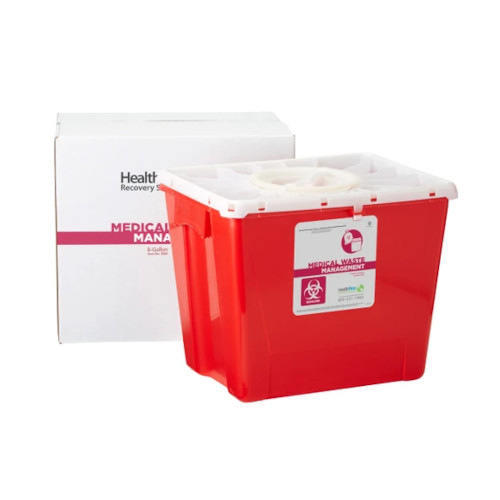Comprehending the Various Kinds Of Garbage Disposal Techniques
In the realm of waste administration, the variety of disposal techniques offered today is substantial and differed, each method serving a distinct purpose in resolving the challenge of waste disposal. click here. From reusing approaches that aim to give new life to products, to the detailed procedures of hazardous waste administration, the landscape of waste disposal is complicated yet essential for environmental sustainability. Understanding the nuances of these different techniques not only drops light on the value of accountable waste monitoring yet additionally motivates us to reassess our approach towards waste disposal in a quickly evolving world

Recycling Techniques
Reusing techniques are important for sustainable waste monitoring methods in both residential and commercial settings. medical waste disposal. By carrying out efficient recycling methods, a considerable amount of waste can be drawn away from garbage dumps, conserving natural deposits and minimizing the environmental effect of manufacturing procedures
In houses, curbside recycling programs play an essential duty in encouraging houses to separate recyclable products from general waste. Products such as paper, plastics, glass, and metals can be sorted and accumulated for processing right into brand-new items, decreasing the demand for raw materials and energy-intensive manufacturing procedures.
Industrial facilities likewise count on reusing methods to lessen waste generation and advertise a circular economic climate. By applying closed-loop systems, companies can reuse materials within their manufacturing procedures, decreasing expenses and ecological footprint. medical waste removal near me. Furthermore, commercial recycling programs typically entail collaborations with specialized reusing facilities to guarantee that products are correctly arranged, refined, and rehabilitated into the supply chain
Composting Techniques

Oxygenated static pile composting involves blending organic waste materials in a large stack and on a regular basis turning it to ensure correct aeration. This approach is efficient for large composting operations. On the various other hand, vermicomposting uses earthworms to break down raw material right into nutrient-rich castings. This strategy is appropriate for smaller-scale operations and families.
In-vessel composting involves putting natural waste in a shut container with regulated conditions for temperature and aeration. Windrow composting includes developing long rows of natural waste and routinely turning them to promote decay - medical waste removal.
Landfill Disposal
Garbage dump disposal is a typically made use of method for handling waste that can not be reused or composted. It involves burying waste in marked areas of land, with proper preventative measures to avoid ecological contamination. Land fills are engineered facilities designed to separate waste from the surrounding setting. The waste is compacted and covered with soil everyday to lower smells, discourage bugs, and reduce the spread of trash. Modern land fills are equipped with protective liners and checking systems to avoid leakage of damaging materials into the soil and groundwater. Methane gas, a by-product of decaying natural waste in landfills, is frequently gathered and made use of as a source of sustainable energy. In spite of improvements in land fill modern technology, concerns remain regarding the lasting ecological influences, such as groundwater contamination and greenhouse gas exhausts. Initiatives to lower dependence on land fills consist of advertising waste decrease, reusing, and checking out alternate waste disposal methods to reduce the environmental footprint connected with typical landfill disposal techniques.

Waste-to-Energy Incineration
Incineration of waste for energy generation is an approach significantly being thought about as a choice to traditional garbage dump disposal strategies. Waste-to-energy incineration involves the combustion of waste materials at high temperature levels, commonly in specialized facilities created to create electricity or warm via the procedure - click here. This method not just reduces the volume of waste that would certainly or else be destined for garbage dumps yet also utilizes the warmth produced throughout incineration to develop energy
One of the crucial benefits of waste-to-energy incineration is its capacity to generate electrical power while lessening the environmental effect contrasted to standard land fill disposal methods. By converting waste into energy, this technique aids in minimizing greenhouse gas emissions and reliance on fossil fuels for energy generation. Furthermore, waste-to-energy centers are furnished with innovative air contamination control modern technologies to alleviate possible toxic wastes launched throughout the burning procedure.
Contaminated Materials Monitoring

Considering the vital significance of responsible waste management techniques, specifically in the world of environmental sustainability, the focus currently moves towards the elaborate domain name of Contaminated materials Administration. Contaminated materials positions significant threats to both human health and wellness and the environment, requiring specialized handling and disposal techniques. Usual examples of hazardous waste consist of chemicals, batteries, pesticides, and electronic waste.
Contaminated materials Administration includes the identification, collection, transport, treatment, and disposal of products considered potentially unsafe or unsafe. This procedure calls for adherence to stringent laws and guidelines to mitigate negative impacts on ecological communities and public health and wellness. Numerous techniques are used in managing contaminated materials, including recycling, secure land fills, encapsulation, and chemical treatment.
Appropriate Hazardous Waste Administration is essential for protecting against contamination of soil, water resources, and air contamination. It is vital for industries, labs, medical care facilities, and various other generators of contaminated materials to execute durable administration approaches, training programs, and emergency situation reaction intends to guarantee the risk-free handling and disposal of these products. Failure to manage harmful waste suitably can have far-reaching consequences, highlighting the value of accountable and thorough techniques in this field.
Conclusion
To conclude, garbage disposal strategies play an important function in handling and decreasing the influence of waste on the environment. From recycling and composting to landfill disposal and waste-to-energy incineration, each technique has its own benefits and restrictions. Appropriate administration of contaminated materials is additionally necessary to protect public health and the environment. It is very important for people and markets to recognize the various garbage disposal methods offered and select the most suitable approach for lasting waste monitoring.
In the realm of waste monitoring, the variety of disposal techniques available today is substantial and varied, each method offering a distinct purpose in addressing the obstacle of waste disposal. click here. From reusing approaches that aim to give brand-new life to products, to the elaborate processes of dangerous waste management, the landscape of waste disposal is intricate yet critical for ecological sustainability. Understanding the subtleties of these various techniques not just drops light on the relevance of liable waste management however likewise prompts us to reassess our approach towards waste disposal in a quickly progressing world
Initiatives to minimize dependence on garbage dumps consist of promoting waste reduction, reusing, and exploring different waste disposal methods to decrease the environmental impact connected with traditional garbage dump disposal practices.
It is click here crucial for industries and individuals to understand the various waste disposal methods available and pick the most suitable approach for sustainable waste administration.